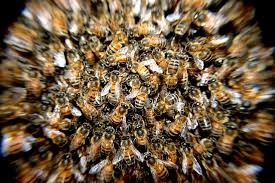Feel beauty supply, post 9
Stepping into Zora

This past weekend I was attacked by yellow jackets after I hit their nest unknowingly with my lawnmower. The episode included me running through the yard screaming, stripping outdoors to my underwear, throwing buckets of water over my body, and jumping into the shower in my socks and undies, where I poured shampoo on my head in great gobs to suffocate the bees stuck in my hair. If the whole scene hadn’t been so traumatic (have you ever looked down and seen your whole leg covered in yellow jackets?), it would have been comical. Given that the incident took place in the swampy southern heat, I thought it was perhaps Zora Neale Hurston’s ghost playing tricks on me. The scene seemed like it could be transformed into one of the “lies” of the mill men who share tall tales in Mules and Men. I think she was reminding me that I was remiss in my writing duties and that this column has now reached the point where we need to discuss Hurston. How could I delay with my lymph nodes still swollen?
For those unfamiliar with Hurston’s book, it was meant as an anthropological study of African American folklore. Under the guidance of Franz Boas, “unquestionably the dominant figure in American anthropology and Hurston’s most influential professor at Barnard College,” Hurston returned to her native town of Eatonville, Florida, with the hopes that she could gain insider access to the folklore she grew up hearing. So the book was not primarily meant as a presentation of a philosophy of art. I doubt that this book appears on syllabi of aesthetics and the only reason it entered into a dialogue with Kant etc. for me was that I happened to teach it in a graduate class on Fabulism(s) in the Fall of 2014. I’m sure, however, that no reader misses the relationship between art and work in this book.
If part of what aesthetic philosophy of the eighteenth century and the Romantic period helped establish was the political power of the middle-class European white male by privileging an ocular-centric imperialist model of human subjectivity, then one of the cultural “gifts” of this work is the lesson that practicing judgments of taste, displaying one’s connoisseurship, distinguishes certain persons as subjects within a field of objects, human or otherwise (recall our discussions of Burke). A person who has taste is human. A person who doesn’t, isn’t. Taste, though it is learned, is continually troped as a natural ability. To lack it, is to lose one’s species-marker. Reducing aesthetic philosophy to this ideological imperative highlights what I’ve been calling the managerial, top-down structure of western aesthetics. An expert tells us what taste or beauty is, if we are human, we quickly learn and display this “natural” behavior. The work in this way helps establish class and racial lines. Curiously, neither the philosopher or his reader are practitioners of art. Neither is a “genius,” but simply a recognizer of genius. And as we saw in Addison, practicing aesthetic judgment civilizes the middling class, gets you out of bed for work without a hangover. Differentiates you from the dregs.
If I follow the logic of western aesthetics and its entanglement with capitalism, we arrive at the usual frustrations/criticisms of the art world. We get the autonomous art object, the separation of art and life via the gallery, the work only as commodity. Yadda Yadda. We get art folding in on itself through cynicism and irony. When the genius can’t make it new anymore, he declares “uncreative writing” as the new thing. Art as McDonald’. But the men in Hurston’s book, they aren’t in this tradition. They in this framework are labor only, unwilling labor, and are making the art of the hangover, art as the refusal of work. They are another tradition. They let us see another possibility.
Examples next time…
FEEL BEAUTY SUPPLY